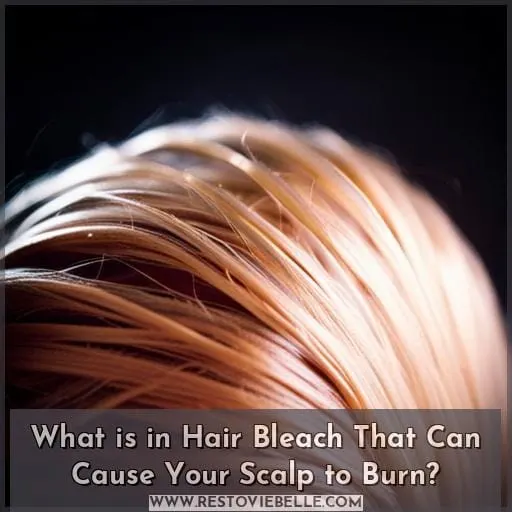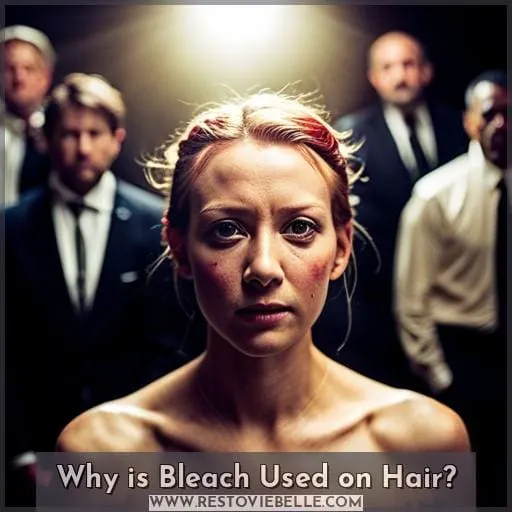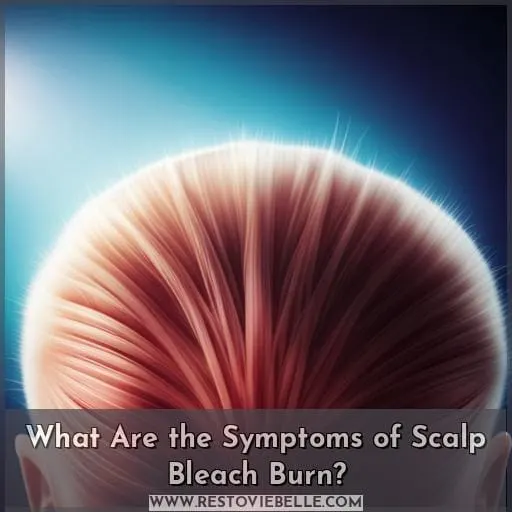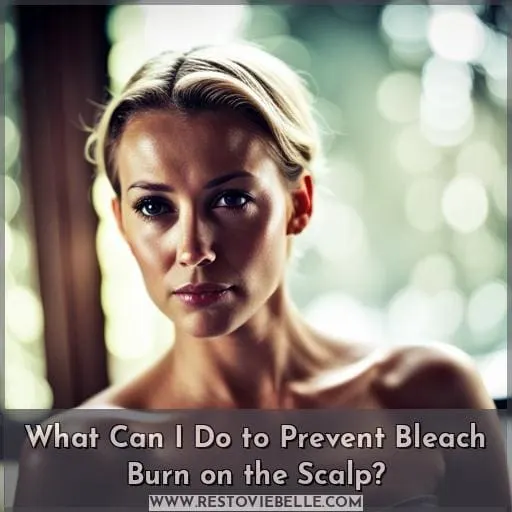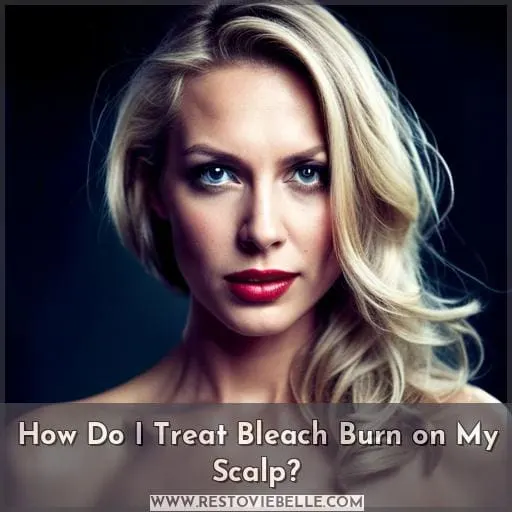This site is supported by our readers. We may earn a commission, at no cost to you, if you purchase through links.
 Are you dealing with scabs on your scalp from bleach usage? If so, it’s time to take action. With its harsh chemicals, hair bleach can leave skin irritated and inflamed – a condition known as chemical burn.
Are you dealing with scabs on your scalp from bleach usage? If so, it’s time to take action. With its harsh chemicals, hair bleach can leave skin irritated and inflamed – a condition known as chemical burn.
In this article, we’ll explore the causes of scalp burns caused by bleaching agents, preventative measures you can take, and effective solutions for healing those pesky scabs that won’t go away.
Table Of Contents
Key Takeaways
- Use alcohol-free aloe vera for moisturizing after bleach rinsing.
- Do not pick at scabs to prevent prolonged healing times and infection.
- Seek medical advice if itching persists or symptoms worsen.
- Treat scalp bleach burns with anti-dandruff shampoos and moisturizing conditioners.
What is in Hair Bleach That Can Cause Your Scalp to Burn?
When lightening your hair, be aware of the potential risks associated with hydrogen peroxide and persulphates in bleaching products that can cause irritation and burns on your skin. Scalp sensitivity is an important factor to consider when using bleach as it may lead to scalp burn or even chemical burn.
Hair damage from hair bleach ingredients like ammonia and hydrogen peroxide can occur if left on for too long or used inappropriately. To prevent this, always consult a dermatologist before beginning any type of treatment involving harsh chemicals such as those found in bleaching agents.
Additionally, conduct patch tests for allergic reactions prior to applying anything onto the scalp. Never wash your hair 3-4 days before bleaching. Moisturize with alcohol-free aloe vera after rinsing off a product you are unsure about.
Use gentle shampoos designed specifically for sensitive scalps during healing periods. Avoid picking scabs at all costs – prolonged healing times will result otherwise.
With these simple steps taken into consideration, you’ll be able to enjoy safe yet effective results while protecting yourself from further harm due to injury caused by chemical burns resulting from improper usage of harmful substances found within some brands’ hair care ranges!
Why is Bleach Used on Hair?
If you’re looking to lighten your hair, using bleach can be a great option. Bleach is used to remove color from the hair and add highlights or create an overall lighter look. It’s important to understand the benefits and risks of bleaching before taking this step though, as there are some potential side effects that come with it, such as scalp burns.
Here are four things you should consider when deciding if bleaching is right for you:
- Hair Bleach Benefits – Bleaching allows for more creative freedom when dyeing your hair since it removes existing color pigment. This means that new colors will show up brighter and bolder than they normally would on darker shades of natural hair color.
- Hair Bleach Risks – The chemicals in bleach can cause scalp irritation if not used correctly, potentially leading to chemical burns.
- Hair Bleach Alternatives – For those who may be susceptible to burning or itching after using bleach, there are other alternatives like semi-permanent dyes which don’t contain any harsh chemicals.
- Treat Scabs On Scalp From Bleaching – If scabbing occurs due to a burn while bleaching, seek medical advice immediately. Use anti-dandruff shampoos followed by a moisturizing conditioner until completely healed.
When considering whether or not hairstyling through bleaching is right for you, understanding all the pros and cons ahead of time will give you peace of mind and allow you to make the most informed decision possible!
What Are the Symptoms of Scalp Bleach Burn?
Experience the intense discomfort of scalp bleach burn with redness, itching, swelling, blistering, and burning. Symptoms of a scalp bleach burn can range from mild to severe depending on how long it is left untreated.
To prevent such an injury, make sure to conduct a patch test for allergic reactions prior to bleaching your hair. Additionally, avoid washing your hair 3-4 days before bleaching as this will protect the scalp’s natural oils and reduce irritation during the process.
To treat minor burns associated with scabs on the scalp from bleach, use cool water for 5-10 minutes. Then, moisturize using alcohol-free aloe vera or products like Sunbum’s After Sun Cool Down Spray, which can help reduce inflammation alongside anti-inflammatory medication such as Advil or ice packs if necessary.
For further relief, ensure you use gentle shampoos made for sensitive scalps throughout the healing process. Remember not to pick at scabs in order to prevent infection and prolonged healing time.
What Can I Do to Prevent Bleach Burn on the Scalp?
Are you considering bleaching your hair? Preparing the scalp, patch testing for allergic reactions, and using a professional hairdresser are essential steps to take in order to prevent bleach burn on the scalp.
Knowing how to properly prepare for and care after bleaching can help ensure that you have a safe and successful experience with lightening your hair color.
Preparing the Scalp Before Bleaching
To prevent scalp irritation from bleaching, it is important to thoroughly prepare the hair and skin prior to application. Protect your scalp with coconut oil or a deep conditioner by using a hair mask overnight for added protection against bleach allergies.
When bleaching at home, use half of what you would normally mix; this helps reduce damage caused by an excessive bleach-to-developer ratio. If unsure about how much product should be used, seek professional guidance from a trusted hairstylist or other qualified hair professionals for safe results when dealing with bleach applications on the scalp.
Patch Testing for Allergic Reactions
Before bleaching, always conduct a patch test to ensure you don’t have an allergic reaction resulting in skin irritation so severe it could make your scalp feel like it’s on fire! Hairdressers should be properly trained and follow necessary guidelines for safety.
Scalp sensitivity is increased during premenstrual periods or after washing hair with shampoo. Applying a coconut mask overnight before bleach can help protect the scalp from burning.
After rinsing off the product, use conditioner from scalp to tip and leave in for at least a day for proper healing of any existing scabbing caused by chemical burns. Advil, ice packs, and alcohol-free aloe vera are useful treatments too. However, if itching persists or the burn doesn’t heal within a reasonable time frame, seek professional medical advice immediately as deep burns require hospitalization and grafting treatment.
Using a Professional Hairdresser
When considering a hair bleaching procedure, always use the services of a professional hairdresser for the best results. A trained stylist will provide expertise on scalp care and color options to ensure your hair comes out exactly as you desire.
Post-bleach maintenance is just as important. They will advise on proper styling after bleach to avoid re-injury or irritation to the scalp. Moreover, they can treat any post-bleach scabs using their specialized knowledge and products like Nizoral Anti Dandruff Shampoo.
With their help, you’ll rest assured knowing that your new look has been achieved safely with minimal damage done along the way.
Avoiding Excessive Heat and Overprocessing
Be mindful of the heat you apply to your scalp while bleaching, as excessive exposure can cause burns and overprocessing may result in scabbing. Hair protection should be a priority when using bleach. Use a thermal protector spray before styling with heat tools.
Overprocessing risks include brittle hair strands, breakage, and damage from split ends. Healthy hair is key, so invest in quality products like moisturizing masks or leave-in treatments for extra nourishment between washes.
To prevent further damage to your tresses, avoid tight hairstyles or pulling too hard on wet locks.
To reduce the risk of scalp burn and scabs, follow these steps:
- Use protective measures such as wearing a scarf around your neck during bleaching.
- Apply conditioner after washing off dye.
- Rinse thoroughly.
- Avoid blow drying.
- Moisturize afterwards with alcohol-free aloe vera gel or a product specifically designed for post-bleach care.
With proper precautions in place, you can achieve beautiful results without compromising the health of your hair!
How Do I Treat Bleach Burn on My Scalp?
If you have experienced a bleach burn on your scalp, then Nizoral Anti-Dandruff Shampoo and applying coconut or olive oil could be the perfect solution for you. This shampoo can help reduce itchy, flaky skin along with controlling dandruff and fungus, while oils will act as natural moisturizers to soothe the area.
Knowing how to properly treat scabs from bleach is essential in avoiding further irritation or infection of your scalp.
Nizoral Anti-Dandruff Shampoo
To help manage scalp issues from bleach, try Nizoral Anti-Dandruff Shampoo for dandruff relief and lasting protection. It contains ketoconazole (1%), is suitable for all hair types, and has been clinically proven to relieve flaking, scaling, and itching.
To prevent a scalp burn or scabbing from one that already exists due to hair bleaching procedures like highlighting or lightening your locks – take precautionary steps like avoiding shampooing the days before dyeing your hair as well as conducting an allergy test beforehand.
Applying Coconut or Olive Oil
Applying coconut or olive oil to the scalp prior to bleaching may help prevent burning and scabbing. A study in 2020 found that up to 85% of participants experienced reduced irritation. Coconut oil has benefits such as its antifungal, antibacterial, and anti-inflammatory properties, which can soothe irritated skin.
Olive oil remedies are also effective for treating scalp burns. Its antioxidants reduce redness while nourishing hair follicles.
When dealing with scalp sensitivity issues, it is important to take hair bleach precautions. This includes avoiding shampooing 3-4 days before bleaching and applying a patch test. If you experience a bleach burn, relief can be achieved by rinsing with cool water for 5-10 minutes.
After rinsing, moisturize the area with alcohol-free aloe vera or products like Sunbum’s After Sun Cool Down Spray. Additionally, anti-inflammatory medication might help reduce inflammation levels around the affected area.
To ensure safety during this process, it is best advised not to pick any kind of scabs on your scalp. Doing so could lead to prolonged healing time and an increased risk of infection.
Rinsing With Apple Cider Vinegar
Rinsing your scalp with apple cider vinegar can help reduce inflammation and soothe the burn. Scalp massage techniques, such as circular motions, while rinsing, will assist in further reducing burning sensations.
For those looking for hair dye alternatives to bleach, DIY hair masks made from natural ingredients like coconut oil or olive oil are great options that may not cause a scalp burn if used properly.
After bleaching, it’s important to be mindful of haircare. Using conditioners specifically created for colored or bleached hair is recommended. Be sure to follow up with an apple cider vinegar rinse as this helps balance pH levels on the scalp and prevents damage from occurring due to chemical treatments or dyes being applied too frequently over time.
Taking extra care after bleaching your hair is always advised!
Washing Hair With a Zinc Pyrithione Shampoo
Reach for a zinc pyrithione shampoo to soothe your itching scalp and reduce inflammation. This powerful ingredient helps control dandruff while promoting hair health, making it ideal for those with sensitive scalps.
Its antibacterial properties help heal the burned area and keep away infection-causing bacteria. It also helps protect against sun damage and keeps the scalp hydrated during the healing process without any irritation or dryness.
With regular use, you can enjoy healthier skin on your head as well as improved hair growth from its stimulating effects on follicles! Zinc pyrithione benefits don’t stop there – it is an effective treatment option that will give you relief from scabs caused by bleach burn in no time!
Applying Cold Milk to Minor Burns
If you’re dealing with minor burns from hair bleaching, try applying some cold milk for quick relief. Cold milk can help soothe the scalp and reduce inflammation caused by sensitivity to bleach.
Make sure to apply a coconut oil mask overnight before bleaching your hair as it will protect the scalp’s natural oils. After washing off the oil, use a thick conditioner on your entire head – from roots to ends – this helps keep moisture in and prevents scabbing during healing.
To further promote healing, rinse your locks with cool water mixed with zinc pyrithione shampoo which has antifungal properties that prevent dandruff while calming itching sensations.
Lastly, refrain from picking any scabs that form due to proper care of minor burns being key for avoiding infections or prolonged healing times!
Taking Ibuprofen for Weeping Sores
Take ibuprofen to soothe the stinging of weeping sores caused by bleach burns, and have a laugh at your own expense while you’re at it! Ibuprofen offers relief from inflammation due to its anti-inflammatory properties.
To treat minor irritation, rinse with cool water for 5-10 minutes or use a milk rinse. A coconut oil hair mask overnight before bleaching can help protect scalp sensitivity.
If symptoms persist after treatment, seek professional medical help as soon as possible. Treatments may include topical antibiotics and oral antihistamines for itching; analgesics such as ibuprofen; antifungal creams or shampoos if infection is present; and corticosteroid injections for severe cases of scalp scabbing from bleach burn.
Be sure to moisturize the area regularly until healing occurs completely!
Other Side Effects of Hair Bleach
Besides the burning and scabbing that may accompany scalp bleaching, there are other potential side effects to be aware of. Scalp sensitivity can cause a burning sensation during bleaching, as well as damaged follicles, hair loss, and normal scabbing after bleaching.
One way to protect your hair from damage is to treat it with coconut oil overnight before bleaching. Afterward, use a thick conditioner for best results. If swelling or weeping occurs on your scalp, rinse with cool water and try a milk rinse for relief.
However, if persistent itching or scabs appear, it is important to speak to your doctor.
Conclusion
It’s only natural to worry about the safety of your scalp when bleaching your hair. After all, it’s not easy to manage the burning, itching, and scabbing that can come with hair bleach. But with a little preparation, patience, and the right products, you can treat your scalp and avoid the dreaded bleach burn.
Start by ensuring your hair and scalp are in good condition before bleaching. Use a patch test to check for possible allergic reactions. If you experience irritation or burning, rinse with cool water and seek the help of a professional hairdresser.
To treat the burn, the anti-dandruff shampoo Nizoral can help reduce flaking and scaling. Applying coconut or olive oil to the scalp overnight can also help reduce burning and itching.
With the right approach and products, you can protect your scalp from bleach and keep it healthy.

